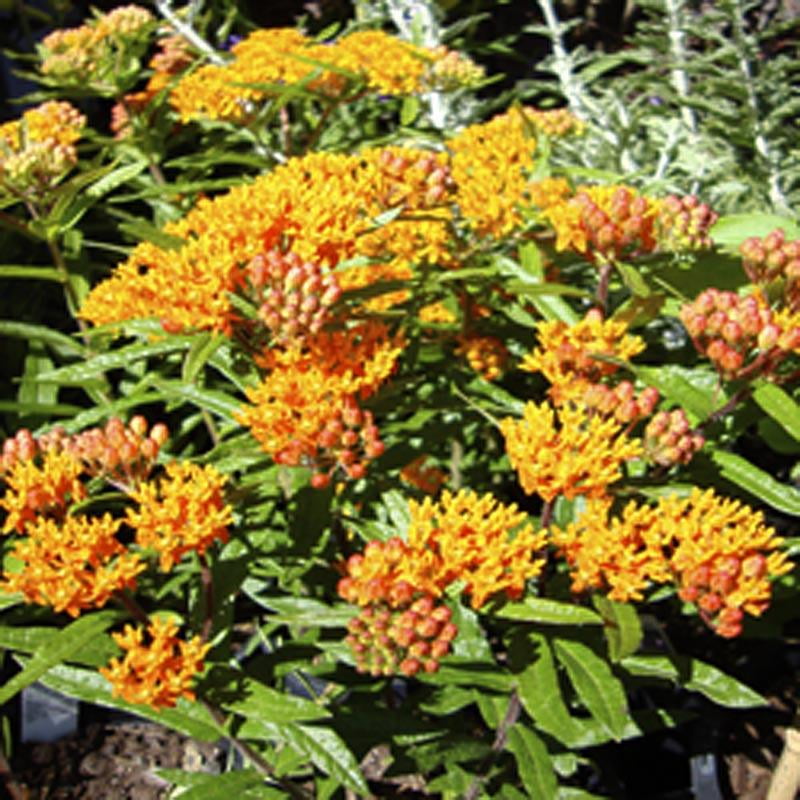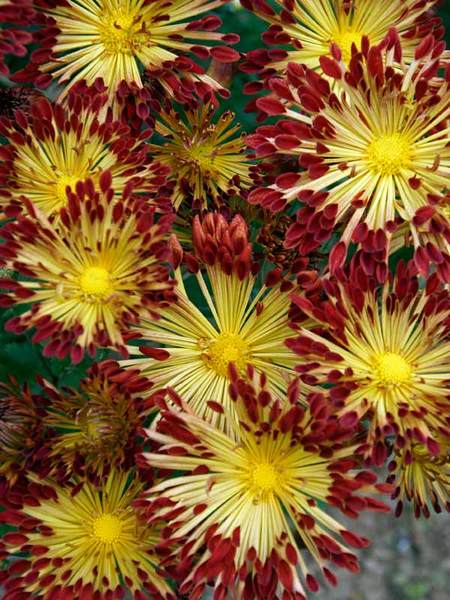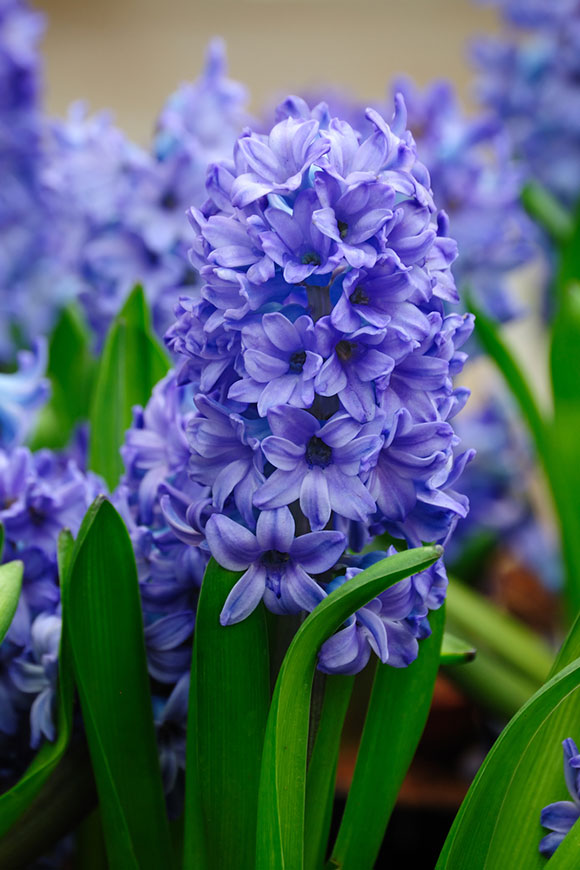Brightly colored fall chrysanthemums, or "mums," are hard to miss as summer winds down and fall approaches. They can be purchased just about any place that sells plants, from garden centers to grocery stores. It's easy to find mums in fall hues of yellow, bronze, purple or burgundy, but they also come in white, pink and red. These plants can either be planted in containers and hanging baskets or stuck into the ground to fill gaps in the garden. Regardless of how they are used, do not expect them to survive the winter. The fall blooming mums that can be purchased late in the growing season have not been bred for cold hardiness.
If they do manage to live through the winter, they seldom bloom again. It is almost always easier to treat them as annuals and add them to the compost heap after the first hard frost. Planting chrysanthemum in the spring gives the perennial plant time to establish and adapt to its new garden home.
You'll easily find mums in garden centers and nurseries in both fall and spring, but planning ahead is key to successful planting. Planting in the spring will also result in a bigger bloom the following season. Although some fall mums can survive winter if planted immediately, the odds are much better with spring-planted mums.
A second winter-survivability consideration is not planting too late in the season. Because mums are one of the last perennial flowers to bloom, they're typically not bought and planted until October—often to replace frost-killed summer annuals. Other times they're not planted at all, instead being used as potted spots of color on decks, patios, porches and front steps. Left outside in above-ground pots, those plants almost always freeze-dry over winter. Mums that are planted in spring, summer or very early fall have a better chance of surviving winter. That earlier planting gives the roots a chance to acclimate and establish, increasing the plant's winter hardiness.
Roots that take hold before the ground freezes also prevent mums from "heaving" out of the ground in winter, leaving the top of the rootball exposed. Even if you like your mums potted in fall, it's better to plant them late when the show's over than not at all. Just water them well, mulch them with about 2 inches of bark mulch or chopped leaves, and tamp them back down ASAP if you find them heaving during winter freezes and thaws. Asters and hardy mums are the two most traditional perennials to grow for fall flower color. Hardy mums are about as easy to grow as a perennial gets. They come in great autumnal colors - yellow, bronze, red, white, orange, burgundy and pink and are usually hardy in zones 5-9.
When buying mums be sure you distinguish between hardy and florist mums. Gorgeous mums in shades of red, yellow, orange, purple, and white pop up everywhere in the fall. I like to use them for autumn displays on my porch, along with dried cornstalks, gourds, and pumpkins. But by the following spring, my plants are usually reduced to clumps of dead stems. After checking in with a few mum-growing pros, I realized I was planting my mums too late. In fact, garden mums are fairly easy to grow, once you know the following common mistakes to avoid.
Amy Enfield, a horticulturist for Miracle-Gro, says garden mums should be planted outdoors by late summer or early fall, so the roots have time to form before the soil freezes. Also known as hardy or Belgian mums, garden mums are sold in garden centers and nurseries, and they're perennials in USDA Zones 5 to 9. But even when they're planted at the right time, they need a few other things, like excellent drainage. Enfield adds, "There's no guarantee they will survive the winter, particularly the further north you live in the U.S." The third key mum-wintering aid is waiting until spring to trim off the cold-killed foliage.
Research has found that the crumbling dead foliage helps insulate the crowns of the plants and increases their cold tolerance. Those amendments will aid drainage and add organic matter and nutrition to the soil. Also work a balanced, granular fertilizer into the soil at planting time. Top the planted bed with 2 inches of mulch and then keep the soil consistently damp the first full growing season. From late spring to mid-summer, pinch back the tips and flower buds on all shoots to make the plant bushier and prepare it for a dramatic fall show.
For optimal blooming, the plants should be fertilized regularly throughout the growing season. After the blooms fade, cut the plants down to about 6 inches, and cover them with straw or another dry mulch to protect the roots over winter. Established plants should be lifted and divided every two to three years. I call the potted mums that make it through the winter my "surprise" mums. I can never decide which mum colors I like best, so I usually end up buying a rainbow of pink, lavender, red, bronze, yellow, gold and white for fall decorating. By the time I've uncovered and/or replanted several winter survivors in the spring, I don't remember what color flowers any particular plant will produce.
It's a lovely surprise in the fall when each mum's tightly closed buds finally open to reveal their color. Because these flowers have developed in my garden instead of being forced into bloom at a nursery, they seem to be extra tough. The fact that I have pinched them back until mid-summer causes the mums to open late -- not before October. Mums aren't exactly "pruned," but are instead pinched throughout the growing season. This helps the plant branch out, become fuller and offer more blooms. When your plant reaches 6 inches tall in the spring, simply pinch off 1 inch of each shoot.
Repeat this every 2 to 3 weeks until early summer.Deadhead spent blooms throughout the fall for an extended bloom time. Once the plant has died in the winter, resist cutting it back. Research reveals that allowing it to die back naturally over the winter produces a stronger plant. Simply clean up the dead stems and foliage in the spring. Caring for fall mums is relatively easy, once you understand their basic needs. According to Better Homes & Gardens, three hours a day is minimal; six or more is better.
Mums that do not receive enough sunlight will lack fullness—imagine seeing more stems instead of leaves and flowers. Like most plants, mums do best in rich, well-drained soil. If your soil is dense, add compost and work it in at least eight inches.
New plantings must never be allowed to wilt and established plants should be watered weekly. Water more often if needed but avoid soaking the plants, as this encourages disease. Regular feeding with a water-soluble fertilizer during growing season will stimulate root growth and help the plants overwinter. Mums set out as fall annuals need not be fertilized in this manner.
If you are selecting mums late in the season, for fall bedding, look for larger, full plants. The National Chrysanthemum Society places them into thirteen distinct classifications, only one of which is called Exotic. On a broader scale, mums can be divided into two groups, the garden variety, sometimes called hardy mums, and the cutting variety, referred to as florist mums.
In a nutshell, garden mums are bred for to survive outdoors, in either pots or beds. They tend to produce stolons, or horizontal runners, beneath the soil surface, which helps produce additional new plants and makes them more likely to survive colder weather. By comparison, cutting mums are bred for their large flowers and tend not to produce those underground runners. If you plant a florist mum outside, it will likely last only as long as the warm weather holds out.
In warmer winter climates, they can be cut back to 6" tall after flowering. Check your local garden center to see what varieties work best in your area. Occasionally garden mums do winterkill, especially if the soil drains poorly or if there are excessive temperature fluctuations in the winter. Since mums have shallow root systems they are very easily damaged by freezing and thawing. This type of winter damage can be prevented with mulching and proper care in the fall. Garden mums are much more likely to survive the winter if the dead plant stems are not removed until the spring.
Additionally, adding a 2-4-inch layer of mulch over the crowns of plants can help. Pine needles, shredded bark, clean straw or evergreen boughs work well, but avoid leaves as these flatten and provide very little insulation. Remove the mulch once the ground thaws in April and cut back dead stems before new growth begins.
Finally, keep in mind that the fall mums sold in garden centers nowadays aren't the same kinds of plants sold 20 years ago, Enfield says. Although garden mums are considered hardy to Zone 5, breeders have developed fall mums with big mounds of showy flowers. This has resulted, she says, in plants that may not be as cold hardy as in the past. So, if your fall-planted mums don't come back like true perennials, just treat them like annuals. Replace them with beautiful, fresh plants when you're ready to do your fall decorating and enjoy their colorful blooms for a season.
Perennial Hibiscus,such as ourSummerific® series, is another class that will add color to the summer and fall garden. They actually start to bloom in mid-summer, but will continue to bloom deep into fall - October up in Michigan. The color range is pink, white, lavender and red, with some gorgeous bicolors. The plants are quite heat tolerant and prefer consistently moist soil. In general, they are hardy in zones 4-9 and are quite large feet tall and wide. However, more compact versions such as Summerific® 'Cranberry Crush,' which is 3-4 feet tall, do exist.
Fall may be fast approaching, but your flowering colors are far from finished. Of course, many summer flowers continue to bloom into fall, at least until the first hard frost. But no plant is more associated with autumn than chrysanthemums, better known as mums. This is because mums tend to continue blooming long after many other flowering plants have ceased for the season. Thousands of cultivars offer varying shapes, sizes and styles, from button mums to single or daisy mums.
These perennials come in many different colors, including some two-tone varieties. They are easy to care for and can be transplanted in bud or in full bloom. When I first began to grow hardy mums, I was delighted to discover that this genus offers tall selections , which can be used to round out a planting and add variety.
I can think of no better one to start with than Chrysanthemum 'Emperor of China' (Z 4–9). Reaching a height of 3 to 4 feet, this selection has dark pink buds that form beautiful double flowers, which are pink with dark centers. The 1½-inch-wide blooms with quilled petals open quite late, usually not until the third week of October, but they last until Thanksgiving if there is no killing frost. 'Emperor of China' can appear lanky, so I recommend placing it in the middle or back of the border or pinching it in late spring. Plants should be inches apart to allow for good circulation and to cut down the chances of powdery mildew.
When the plants come up in the spring, let them grow to about 4 inches tall and then pinch the top off each shoot, leaving about 3 to 4 leaves on the stalk. Do this about every other week or so until the July 4. When you stop pinching them, they will set flower buds on well-formed, compact plants.
You can keep the plants attractive by deadheading spent flowers. Do not cut the plants to the ground at the end of the season. I know it looks ugly, but the crown of the plant is protected by its dead stalks. Add some mulch around the plants and wait until spring to remove the old plant material. If you live in a cold climate, it is best to leave the foliage on the plant, even after it has browned and died, to increase the plant's chance of surviving the winter.
In spring, you can prune out the dead leaves before the new ones start to develop. If you want to grow a perennial chrysanthemum, purchase hardy, named varieties and plant them in the ground in full sun on well-drained soil. Container plants should be moved to a protected spot in winter. Plant mums at least 6 weeks before your first killing frost in fall. That's usually early- to mid-September, depending on your location.
Leave the foliage on the plant after frost so it can catch blowing snow for winter protection. You can also cut it back to the ground and pile bark mulch on the plant to protect the roots. It seems as soon as the air cools, signaling the coming of fall, garden centers begin showcasing full mounds of brilliant red, yellow, and violet flowers. Chrysanthemums, or mums, are a staple in fall gardens. Mums are a national symbol of fall abundance, and this herbaceous and hardy perennial is an easy addition to give a gorgeous pop of color in your fall garden landscape.
With a little understanding and a few simple tips, you can have a lush, beautiful fall chrysanthemum garden display to help celebrate the changing of seasons. Garden mums (Chrysanthemum spp.) are herbaceous perennials in the daisy family and are stalwarts of the flowering autumn garden. When garden centers sell blooming potted mums in the fall, they are usually used as annuals and discarded when the blooms fade. And when gardeners try to transplant these mums into the ground late in the season, chances are they won't make it through winter and become perennial. Sun-loving celosias are annuals that come in orange, white, yellow, pink, red and purple.
Some of their flowers look like plumes or bottlebrushes,, while others resemble cockscombs. You'd have to start celosia seeds early in the year for fall flowers, but plants are usually easy to find in garden centers and nurseries. These carefree plants have attractive foliage, too, in colors like blue-green, chartreuse, purple-green and burgundy.
Snip the flowers, if you like, and save them for dried arrangements. The best gardens have plants that add color and interest in all seasons. Spring and summer are usually pretty simple to fill with color. It can take a bit more planning to keep the garden looking great late summer into fall and winter.
However, with a bit of careful plant selection your garden can brim with interest in every season. The plants that are a bit overlooked are perennials and shrubs that flower, fruit or have showy foliage in fall. My first experience with overwintering a chrysanthemum was a happy accident. After my garden center mums were done blooming at the end of the fall, I removed them from their pots and tossed them into the compost pile. The following spring, I was surprised to find healthy new chrysanthemum leaves sprouting from the sides of the pile.




























